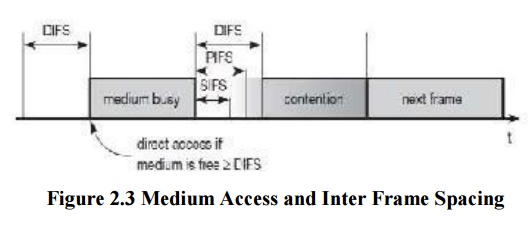Chapter: Mobile Networks : Wireless Networks
Services - Wireless Networks
SERVICES
The MAC
layer has to fulfill several tasks. First of all, it has to control medium
access, but it can also offer support for roaming, authentication, and power
conservation. The basic services provided by the MAC layer are the mandatory asynchronous data service and an
optional time-bounded service. While
802.11 only offers the asynchronous service in ad-hoc network mode, both
service types can be offered using an infrastructure-based network together
with the access point coordinating medium access. The asynchronous service
supports broadcast and multi-cast packets, and packet exchange is based on a
‗best effort‘ model, i.e., no delay bounds can be given for transmission. The
following three basic access mechanisms have been defined for IEEE 802.11: the
mandatory basic method based on a version of CSMA/CA, an optional method
avoiding the hidden terminal problem, and finally a contention- free polling
method for time-bounded service. The first two methods are also summarized as distributed coordination function (DCF), the third method is
called point coordination function (PCF). DCF only offers asynchronous service,
while PCF offers both asynchronous and time-bounded service but needs an access
point to control medium access and to avoid contention. The MAC mechanisms are
also called distributed foundation wireless medium access control (DFWMAC).
For all access methods, several parameters
for controlling the waiting time before medium access are important. Figure 7.9
shows the three different parameters that define the priorities of medium
access. The values of the parameters depend on the PHY and are defined in
relation to a slot time. Slot time
is derived from the medium propagation delay, transmitter delay, and other PHY
dependent parameters. Slot time is 50 μs
for FHSS and 20 μs for DSSS. The
medium, as shown, can be busy or idle (which is detected by the CCA). If the
medium is busy this can be due to data frames or other control frames. During a
contention phase several nodes try to access the medium.

Short inter-frame spacing (SIFS):
The
shortest waiting time for medium access (so the highest priority) is defined
for short control messages, such as acknowledgements of data packets or polling
responses. For DSSS SIFS is 10 μs and
for FHSS it is 28 μs.
PCF inter-frame spacing (PIFS):
A waiting
time between DIFS and SIFS (and thus a medium priority) is used for a
time-bounded service. An access point polling other nodes only has to wait PIFS
for medium access. PIFS is defined as SIFS plus one slot time.
DCF inter-frame spacing (DIFS):
This
parameter denotes the longest waiting time and has the lowest priority for
medium access. This waiting time is used for asynchronous data service within a
contention period. DIFS is defined as SIFS plus two slot times.